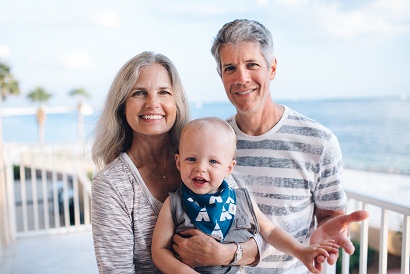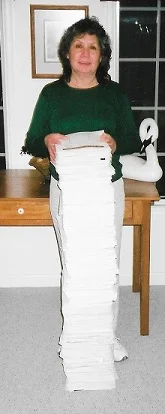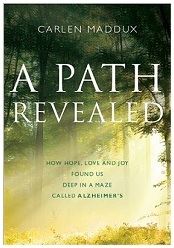For the first four decades of marriage, Bob and Kaki busily went about making a living in the Nashville area, growing a family of two daughters, traveling, being involved in their church, playing and working with friends. Bob, now 76, worked in computer system sales, advertising, marketing, and consulting. Kaki, 75, taught middle school.
Describing Kaki, Bob wrote a note last year in her voice. Here’s an excerpt: “I was amazed and thrilled when first holding my new born daughters; being their mother is the most fulfilling experience of my life. I have marveled at the first sunrise in North America from Cadillac Mountain in Maine and watched the sun set from Haleakala on Maui. I panned for gold in Alaska, fascinated by the dancing Northern Lights; watched the Penguin Parade in South America and Australia; enjoyed a string concert in Vienna; Ballet Folklórica in Mexico City; sailed to many islands in the Caribbean; and dove into the deep blue off Tahiti.
“I accomplished a personal objective to visit and enjoy the beauty of all fifty of our United States and the pleasure of 70-plus national parks, battlefields, monuments, and recreation areas. I enjoyed park concerts, waterfalls, hiking, quilting, and good red wine.”
I asked Bob some questions, which he readily answered. Our conversation is edited for brevity and clarity:
Me: When did you notice a possible problem with Kaki?
Bob: I first suspected dementia in early 2006. (Kaki was 64.) We were on a cruise outside Rio de Janeiro. Kaki always had a perfect sense of direction, but on the ship she couldn’t find her way back to our room. A little later I noticed Kaki had problems with balancing our checkbook, which she’d done throughout our marriage.
CM: When did you know for sure?
BB: It wasn’t until 2009 that Kaki was diagnosed with mild cognitive impairment. For a while, our two daughters didn’t recognize the problem because they don’t live here, and Kaki could cover it up well during short visits. (Andi, 48, lives outside Knoxville and Susi, 45, is in Atlanta.) I finally asked each one to come separately and spend three days and two nights with their mother.
Afterwards, when we were all together, Kaki, Andi, Susi, and I went out on the back porch and had a long cry. Kaki then agreed to go for an evaluation.
CM: Is Kaki still at home?
BB: Yes, I’m still able to care for her. I spend about four hours every morning just relearning how important it is to move at her speed. After all this time, I still want to move and get things done and get on to the next thing. Our only real routine is morning bathroom, breakfast in bed, shower when necessary, dress, nap, and get ready for the day. I usually need to feed her.
CM: Do you have help?
BB: To a degree. Kaki goes to a day care center twice a week for 4-6 hours a visit. I almost always go to Panera Bread after dropping her off. I started going there just to be in the presence of other adults; it’s been a great place to relax and see others enjoying good food and life.
A caregiver also comes in two Sunday mornings a month, which allows me to go to my Sunday School class, church, and then brunch with friends. Our daughters also give me a weekend off every couple of months.
I experimented with bringing a caregiver into the house, but Kaki ran her off. These days, Kaki’s frustrations can quickly turn to anger.
CM: Does Kaki still recognize your family and friends?
BB: She always recognizes Andi and Susi. It takes her five minutes or so to recognize our three grandchildren. As for friends, I’ve heard her in the past say, “I don’t know your name, but I know you’re someone I love.” Kaki’s always ready for a hug.
CM: What are you doing to take care of yourself?
BB: Not enough. Until 2015, I walked consistently in our neighborhood park but now I’m reluctant to leave Kaki alone. I will walk when I take Kaki to the day care center and don’t have other errands to run. And then our church’s Stephen Ministry members stay in close touch with us. (The Stephen Ministry helps connect the needs and gifts of church members on a one-to-one basis. Bob was an active member in this group until he no longer could be.)
I do participate in a support group, the second Tuesday evening of every month. Our friend Dr. Petrie leads this. He really lets the questions and concerns arise within the group. (Dr. William Petrie is a geriatric physician at Vanderbilt, whose mother had dementia. He’s also Kaki’s doctor.)
CM: I share in my book, A Path Revealed, that taking my wife’s car keys was one of the toughest times we faced. How was it for you?
BB: Fortunately, we have a service here in Nashville that helps with that. Vanderbilt’s Bill Wilkerson Center will evaluate driving skills when referred by a medical doctor. I can’t say enough good things about the way the center conducted the driving test and the sensitive debriefing they gave Kaki and me. They’ve done this so many times that no one ends up being the bad guy.
CM: Are you afraid of anything at this point?
BB: One of my big concerns is the best way to handle our financial plans. I expect most of us who are faced with long-term dementia issues are worried about running out of money. The quality of health care available to our loved ones is largely dependent on our financial wellbeing.
CM: You’ve been at this a long time, Bob. If a friend asked for your insight into dealing with a spouse’s dementia, what would you say?
BB: Interesting that you should ask that, because it’s already happened a couple of times. I’ve actually typed these on to my iPhone notes:
- First, get out of denial.
- Educate yourself about dementia.
- Find support from other caregivers.
- Address legal documents and plans.
- And finally, but certainly not last …Love one another and have fun while you can!
CM: Any other thoughts?
BB: Yes. I recognize we’re on a long journey, and I don’t know how much further it will be. So far it’s been 11 years, and I still appreciate learning from those who have gone before and are willing to share their experience and thoughts.
CM: Thank you, Bob, for your willingness to share with us.
~~~~~~~~~~~~~~~~~
Next month I’m going back on the road to share our story with a couple of groups. If you’re in the vicinity of either, please think about coming. I’d love to see you.
- Tuesday, July 25, 7-8pm… Montreat Conference Center. (near Black Mountain, NC, about 15 miles east of Asheville.) I’ll be talking during one of the Summer Lecture Series, in the Lower Left Bank building. Our children David, Rachel, and Kathryn will be here with their families. My wife Martha grew up in Montreat in the summers, often calling it “my real home.” Our family’s had a summer cabin here since 1980.
- Sunday, July 16, 10am… The Reserve Worship service. Sunset, SC, north of Clemson and west of Spartanburg. Reserve Worship describes itself as “a multi-denominational gathering.” I was invited by my friend Pamela Smith; we’ve known each other longer than we can remember, having gone through elementary and high school together.
Have a great Fourth of July,
Carlen
carlenmaddux@maddux.com
www.carlenmaddux.com
P.S. If you’d like to share your story in dealing with a crisis, whether health or otherwise, please email me here. A handful of other readers already are participating.
P.P.S. As usual, feel free to forward this post to your friends and family. If you’d like to sign up for my blog, it’s free; just click here. Also, my book, A Path Revealed: How Hope, Love, and Joy Found Us Deep in a Maze Called Alzheimer’s, can be found on Amazon or ordered from any bookstore.























































